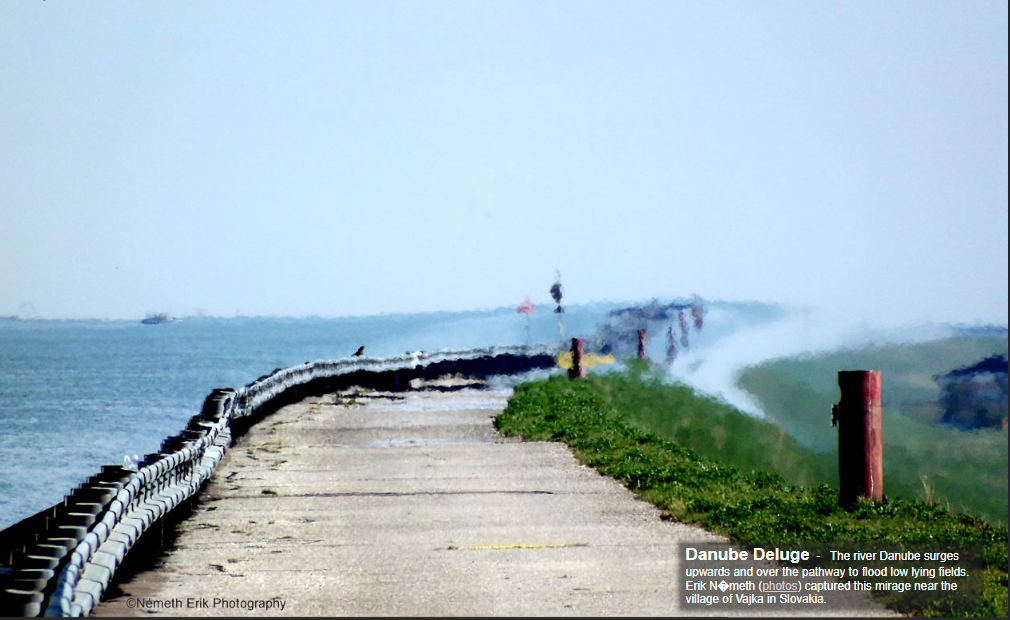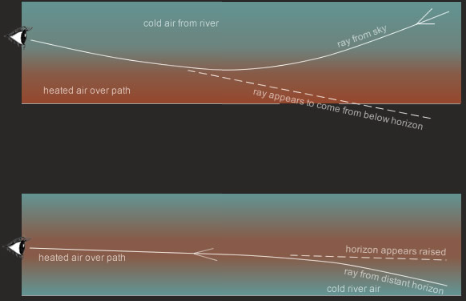OPOD - Danube Flood?
OPOD - Danube Flood: A Mesmerizing Atmospheric Mirage
The Danube River, known for its beauty and grandeur, has captivated the attention of many. However, on April 4th, 2012, an extraordinary phenomenon occurred near the village of Vajka in Slovakia. Erik Németh managed to capture a breathtaking mirage of the Danube flooding low-lying fields, creating a mesmerizing optical illusion that left spectators in awe.
The scene unfolded at 14:10 on a sunny day, as the Danube flowed calmly while the sun's rays heated the pathway. A gentle breeze carried cool air from the river, causing a temperature gradient between the warm walkway and the cooler air above. This temperature difference played a crucial role in creating the stunning mirage that unfolded before Németh's lens.
The warm air near the ground created an inferior mirage, a phenomenon commonly observed on sun-heated roads during the afternoon. As the warm air interacted with the cooler air above, turbulence and convective currents distorted the distant scene, blurring the boundaries between reality and illusion. The turbulent air swept over to the lower level fields on the right, further enhancing the surreal nature of the mirage.
A peculiar bulging effect became apparent as one gazed into the distance over the heated walkway. The river's surface appeared elevated compared to the undistorted horizon on the left. This optical illusion was a result of the refractive properties of light passing through thermal gradients. Rays of light emerged from the colder air near the water's surface and entered the warmer air above, causing them to refract and create the illusion of an elevated horizon.
As warm air was forced downward by the breeze, it descended into the low-lying land on the right, giving rise to an extensive and turbulent inferior mirage. The swirling patches of light blue "water" observed in this area were actually mirages of the sky above, mingling with the darker blue hues of the Danube directly over the walkway. This interplay of colors and textures added to the overall enchantment of the spectacle.
This mirage observed on the Danube was particularly intriguing due to its complex nature. Unlike typical mirages that occur across horizontal air layers with different temperatures, this mirage exhibited temperature gradients both from left to right and along the line of sight. This complexity made it a fascinating subject for comparison with other intricate mirages, such as the one witnessed on the long jetty at Alderney.
In conclusion, the captivating mirage captured by Erik Németh near the village of Vajka on the Danube River is a testament to the mesmerizing beauty of atmospheric optics. The interplay of temperature gradients, convective currents, and refractive properties of light combined to create a visual spectacle that defied conventional perception. Such extraordinary phenomena remind us of the wonders that nature can unfold before our eyes, leaving us in awe of its complexity and beauty.

Danube Deluge - The river Danube surges upwards and over the pathway to flood low lying fields. Erik N�meth (photos) captured this mirage near the village of Vajka in Slovakia.
14:10 on a sunny day, 4th April 2012. The Danube flowed cool while the sun heated the path. A slight breeze carried cool air left to right from the river up the shaded river bank and over the path.
The sky �reflections� on the warm walkway signal an inferior mirage caused by warmer air beneath cooler. For the same reason inferior mirages are often seen in the afternoon on sun heated roads. Further away, the scene becomes blurred by turbulence from air convecting upwards from the path and mixing with the cooler Danube air. The blurring turbulent air is swept over to the lower level fields at the right.
The distant scene over the heated walkway bulges strangely upwards. The river surface itself appears raised compared to the undistorted horizon at left. Most of the nearby air is warm whereas the distant water near the horizon is cold. Rays are emerging through cold air into warmer. They are refracted by the ensuing thermal gradients making the horizon appear raised. The horizon bulges highest over the distant walkway, itself raised, where the air is heated most.
Warm air is forced down by the breeze into the low level land at right where it forms an extensive and turbulent inferior mirage. The light blue �water� swirling downwards is actually an inferior mirage of the sky above. Patches of light blue miraged sky are also mixed with the darker blue of the Danube directly over the walkway.
We see most mirages looking across horizontal air layers at different temperatures. This Danube mirage is more complicated because there are temperature gradients from left to right and also along the line of sight. Compare it with another complex mirage, that of the long jetty at Alderney.
Thanks to Andrew Young for interpretation, errors are mine!

Note: this article has been automatically converted from the old site and may not appear as intended. You can find the original article here.
Reference Atmospheric Optics
If you use any of the definitions, information, or data presented on Atmospheric Optics, please copy the link or reference below to properly credit us as the reference source. Thank you!
-
<a href="https://atoptics.co.uk/blog/opod-danube-flood/">OPOD - Danube Flood?</a>
-
"OPOD - Danube Flood?". Atmospheric Optics. Accessed on December 27, 2024. https://atoptics.co.uk/blog/opod-danube-flood/.
-
"OPOD - Danube Flood?". Atmospheric Optics, https://atoptics.co.uk/blog/opod-danube-flood/. Accessed 27 December, 2024
-
OPOD - Danube Flood?. Atmospheric Optics. Retrieved from https://atoptics.co.uk/blog/opod-danube-flood/.